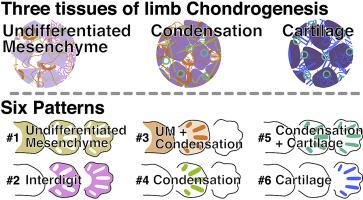当前位置:
X-MOL 学术
›
Dev. Biol.
›
论文详情
Our official English website, www.x-mol.net, welcomes your
feedback! (Note: you will need to create a separate account there.)
The tissues and regulatory pattern of limb chondrogenesis.
Developmental Biology ( IF 2.5 ) Pub Date : 2020-05-14 , DOI: 10.1016/j.ydbio.2020.04.009 Donald A Fowler 1 , Hans C E Larsson 2
Developmental Biology ( IF 2.5 ) Pub Date : 2020-05-14 , DOI: 10.1016/j.ydbio.2020.04.009 Donald A Fowler 1 , Hans C E Larsson 2
Affiliation

|
Initial limb chondrogenesis offers the first differentiated tissues that resemble the mature skeletal anatomy. It is a developmental progression of three tissues. The limb begins with undifferentiated mesenchyme-1, some of which differentiates into condensations-2, and this tissue then transforms into cartilage-3. Each tissue is identified by physical characteristics of cell density, shape, and extracellular matrix composition. Tissue specific regimes of gene regulation underlie the diagnostic physical and chemical properties of these three tissues. These three tissue based regimes co-exist amid a background of other gene regulatory regimes within the same tissues and time-frame of limb development. The bio-molecular indicators of gene regulation reveal six identifiable patterns. Three of these patterns describe the unique bio-molecular indicators of each of the three tissues. A fourth pattern shares bio-molecular indicators between condensation and cartilage. Finally, a fifth pattern is composed of bio-molecular indicators that are found in undifferentiated mesenchyme prior to any condensation differentiation, then these bio-molecular indicators are upregulated in condensations and downregulated in undifferentiated mesenchyme. The undifferentiated mesenchyme that remains in between the condensations and cartilage, the interdigit, contains a unique set of bio-molecular indicators that exhibit dynamic behaviour during chondrogenesis and therefore argue for its own inclusion as a tissue in its own right and for more study into this process of differentiation.
中文翻译:

肢体软骨形成的组织和调控模式。
最初的肢体软骨形成提供了类似于成熟骨骼解剖结构的第一个分化组织。它是三个组织的发育过程。肢体以未分化的间充质1开始,其中一些分化为凝结2,然后该组织转变为软骨3。每个组织都通过细胞密度,形状和细胞外基质组成的物理特征来识别。基因调控的组织特异性机制是这三种组织的诊断物理和化学特性的基础。这三种基于组织的方案在其他组织和肢体发育时间框架内的其他基因调节方案的背景下共存。基因调控的生物分子指标揭示了六个可识别的模式。这些模式中的三个描述了三个组织中每个组织的独特生物分子指示剂。第四个模式在凝结和软骨之间共享生物分子指示剂。最后,第五种模式由在未进行任何缩合分化之前在未分化的间充质中发现的生物分子指示剂组成,然后这些生物分子指示剂在缩合中上调而在未分化的间充质中下调。保留在凝结和软骨之间的未分化间充质,指间,包含一组独特的生物分子指示剂,这些指示剂在软骨形成过程中表现出动态行为,因此主张将其自身包括为组织,并为此进行进一步研究分化过程。第四个模式在凝结和软骨之间共享生物分子指示剂。最后,第五种模式由在未进行任何缩合分化之前在未分化的间充质中发现的生物分子指示剂组成,然后这些生物分子指示剂在缩合中上调而在未分化的间充质中下调。保留在凝结和软骨之间的未分化间充质,指间,包含一组独特的生物分子指示剂,这些指示剂在软骨形成过程中表现出动态行为,因此主张将其自身包括为组织,并为此进行进一步研究分化过程。第四个模式在凝结和软骨之间共享生物分子指示剂。最后,第五种模式是由在未进行任何缩合分化之前在未分化的间充质中发现的生物分子指示剂组成的,然后这些生物分子指示剂在缩合中上调而在未分化的间质中下调。保留在凝结和软骨之间的未分化间充质,指间,包含一组独特的生物分子指示剂,这些指示剂在软骨形成过程中表现出动态行为,因此主张将其自身包括为组织,并为此进行进一步研究分化过程。第五种模式是由在未进行任何缩合分化之前在未分化的间充质中发现的生物分子指示剂组成的,然后这些生物分子指示剂在缩合中被上调而在未分化的间充质中被下调。保留在凝结和软骨之间的未分化间充质,指间,包含一组独特的生物分子指示剂,这些指示剂在软骨形成过程中表现出动态行为,因此主张将其自身包括为组织,并为此进行进一步研究分化过程。第五种模式是由在未进行任何缩合分化之前在未分化的间充质中发现的生物分子指示剂组成的,然后这些生物分子指示剂在缩合中被上调而在未分化的间充质中被下调。保留在凝结和软骨之间的未分化间充质,指间,包含一组独特的生物分子指示剂,这些指示剂在软骨形成过程中表现出动态行为,因此主张将其自身包括为组织,并为此进行进一步研究分化过程。
更新日期:2020-05-15
中文翻译:

肢体软骨形成的组织和调控模式。
最初的肢体软骨形成提供了类似于成熟骨骼解剖结构的第一个分化组织。它是三个组织的发育过程。肢体以未分化的间充质1开始,其中一些分化为凝结2,然后该组织转变为软骨3。每个组织都通过细胞密度,形状和细胞外基质组成的物理特征来识别。基因调控的组织特异性机制是这三种组织的诊断物理和化学特性的基础。这三种基于组织的方案在其他组织和肢体发育时间框架内的其他基因调节方案的背景下共存。基因调控的生物分子指标揭示了六个可识别的模式。这些模式中的三个描述了三个组织中每个组织的独特生物分子指示剂。第四个模式在凝结和软骨之间共享生物分子指示剂。最后,第五种模式由在未进行任何缩合分化之前在未分化的间充质中发现的生物分子指示剂组成,然后这些生物分子指示剂在缩合中上调而在未分化的间充质中下调。保留在凝结和软骨之间的未分化间充质,指间,包含一组独特的生物分子指示剂,这些指示剂在软骨形成过程中表现出动态行为,因此主张将其自身包括为组织,并为此进行进一步研究分化过程。第四个模式在凝结和软骨之间共享生物分子指示剂。最后,第五种模式由在未进行任何缩合分化之前在未分化的间充质中发现的生物分子指示剂组成,然后这些生物分子指示剂在缩合中上调而在未分化的间充质中下调。保留在凝结和软骨之间的未分化间充质,指间,包含一组独特的生物分子指示剂,这些指示剂在软骨形成过程中表现出动态行为,因此主张将其自身包括为组织,并为此进行进一步研究分化过程。第四个模式在凝结和软骨之间共享生物分子指示剂。最后,第五种模式是由在未进行任何缩合分化之前在未分化的间充质中发现的生物分子指示剂组成的,然后这些生物分子指示剂在缩合中上调而在未分化的间质中下调。保留在凝结和软骨之间的未分化间充质,指间,包含一组独特的生物分子指示剂,这些指示剂在软骨形成过程中表现出动态行为,因此主张将其自身包括为组织,并为此进行进一步研究分化过程。第五种模式是由在未进行任何缩合分化之前在未分化的间充质中发现的生物分子指示剂组成的,然后这些生物分子指示剂在缩合中被上调而在未分化的间充质中被下调。保留在凝结和软骨之间的未分化间充质,指间,包含一组独特的生物分子指示剂,这些指示剂在软骨形成过程中表现出动态行为,因此主张将其自身包括为组织,并为此进行进一步研究分化过程。第五种模式是由在未进行任何缩合分化之前在未分化的间充质中发现的生物分子指示剂组成的,然后这些生物分子指示剂在缩合中被上调而在未分化的间充质中被下调。保留在凝结和软骨之间的未分化间充质,指间,包含一组独特的生物分子指示剂,这些指示剂在软骨形成过程中表现出动态行为,因此主张将其自身包括为组织,并为此进行进一步研究分化过程。









































 京公网安备 11010802027423号
京公网安备 11010802027423号